Wireless HD Video: Extender-Video Senders, or Wire Replacers
Hello, dear readers of Habrahabr. In today's article, I would like to continue the cycle of articles on wireless audio-video transmission ( 1 , 2 , 3 ) and highlight such a class of wireless devices transmitting HD-video and audio as extenders. These devices are often referred to as “video senders,” although this word reflects only part of the functionality responsible for video transmission.
((Caution, Traffic!))
')
So, before rushing to study specific pieces of iron, let's first look into the essence of the extenders themselves. The word extender comes from the English verb “extend” - to expand. That is, the devices are designed to expand the transmission of video and sound from one device to another / others, while the receiving and transmitting devices themselves should not “strain” and “notice” any intermediate units. Transmission should be transparent.
Why is it taken exactly HD-video and nothing less? - you ask. The answer is: in fact, through extenders, you can transfer not only HD, but since all the units considered in the article are relevant for today, they are aimed at working with the modern HDMI interface, which combines video and sound, and is oriented mainly to HD quality, we’ll dwell on it. In the end, if you are still interested in transmitting video and sound wirelessly with devices from the “pre-HD-shnoy” era, you can look into the very first article, there are several links. But back to the extenders.
In short, extenders are designed to simply remove the HDMI wire without loss of signal transmission between any devices that can be connected with this wire.
For example, suppose you have a Sony PlayStation 3 or Xbox 360 console , or a laptop with an HDMI / DVI output , from which / from which you want to transmit wireless video and high-quality sound to an HD TV. Then, instead of a long connecting HDMI cable to a set-top box or laptop via HDMI (if in a DVI laptop, via an adapter) you connect the first component of the extender - the transmitter (transmitter) to the TV, also using HDMI, connect the second component of the extender - the signal receiver (reciever ). Wireless communication is established between the transmitter and receiver. It doesn’t matter to you what protocol and its characteristics are used there, you have everything left as it was: HDMI at the input, HDMI at the output. Only between the source and receiver there are no wires. No need to install any drivers or additional software, your devices will still think that they are connected by an HDMI cable.
Again, do not forget that additional energy is required for receiving and transmitting such data volumes, so both the receiver and the transmitter as part of the extender must be plugged into an electrical outlet or, if the extender manufacturer has provided such a possibility, power the transmitter and / or receiver the port .
I repeat that any device with an HDMI output can act as sources in such a scheme: set-top boxes, DVD / Blueray players, media servers (for example, like Bumburum has), video cards and motherboards, as well as nettops with built-in port HDMI, laptops, smartphones and tablets (the same HTC EVO 4G or Dell Streak with the ability to output an HDMI signal).
The receiver, respectively, can be any device that has an HDMI input , of which there is now a great variety: HD-ready and FullHD TVs, monitors, projectors, audio-video capture cards.
At the heart of extenders, even though this is transparent to the user, it is still some kind of standardized, or proprietary, wireless signal transmission technology. The main technologies of this kind were discussed in sufficient detail in the previous article, so we can only group the existing solutions by the technologies used and give them consumer evaluations.
Grades will be awarded in the following categories:
- Video up to 1080i inclusive, and stereo sound or 5.1 - rating 3 .
Thinking a little, I decided not to inflate this, and so already resulting not very small, review, therefore, a detailed description of (irrelevant) devices with only 1080i support will be omitted. I can only say that at different times in this field Sony , Philips , Belkin managed to be noted.
- Video up to 1080p @ 30Hz (30fps, frames / sec.) Inclusive, and sound 5.1 - rating 4 .
- Video up to 1080p @ 60Hz inclusive, sound 7.1 - rating 5 .
- one room (10-20 meters), direct visibility, but possible obstacles (chair, person) - score 3.5 .
- the signal passes through the walls, 30-50 meters - grade 5 .
- up to $ 300 - rating 5 .
- up to $ 500 - rating 4 .
- over $ 500 - rating 3 .
And we start with ...
Since all the pieces of hardware listed below are built on the same SiBEAM chip (more about this in the previous article), they will differ only in brand, price and appearance. So, the general assessment for all for quality and distance:
Now (hooray!) Glands:
GEFENTV WirelessHD for HDMI

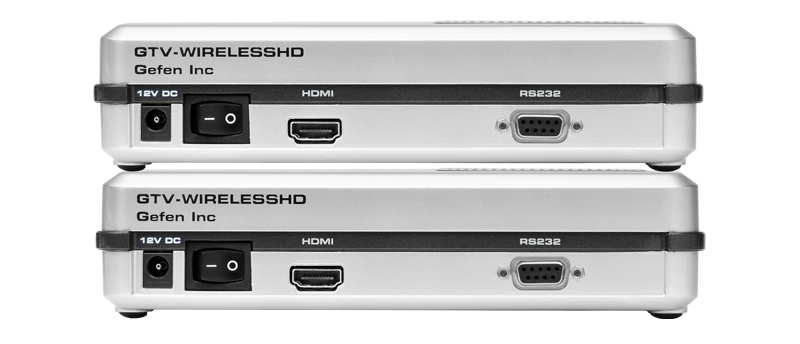

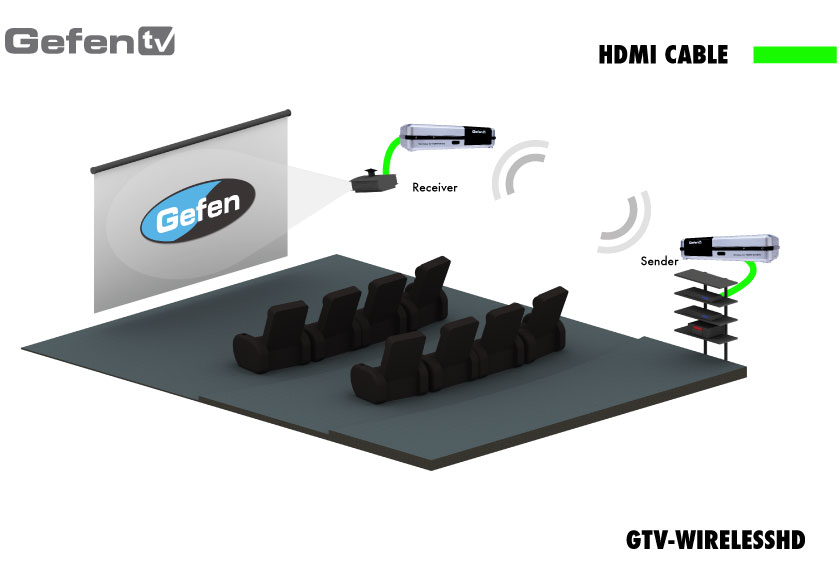
BEST BUY Rocketfish WirelessHD

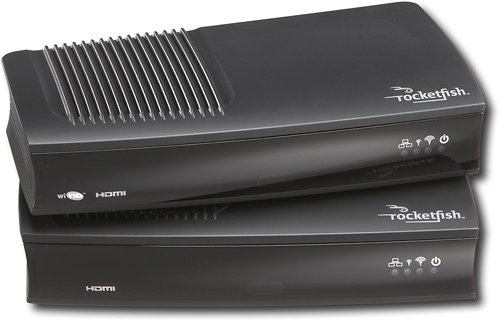
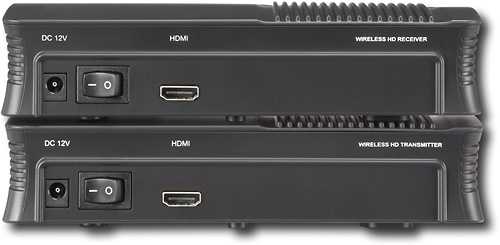
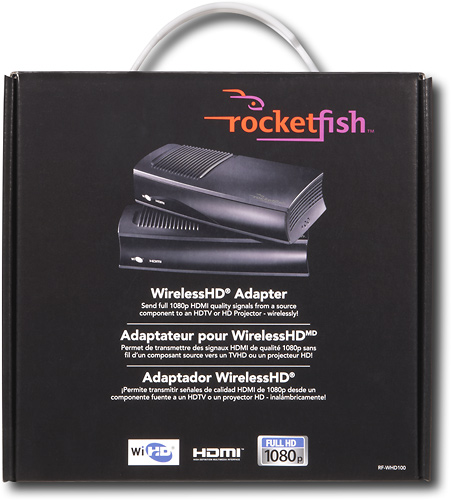
Cables To Go TruLink 1-Port 60GHz WirelessHD Kit

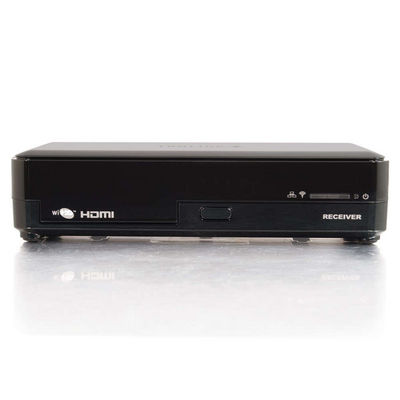


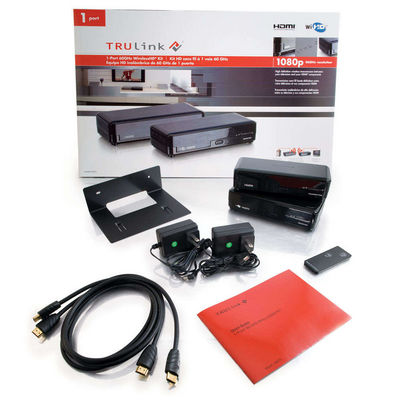
As you can see, all devices are quite expensive and are not capable of transmitting a signal through any serious obstacles. However, in return we get the highest (say, even the highest possible) HD video quality 1080 @ 60fps and 7.1 sound without a single delay. As a brief fact about the product, I will say that the boxes use a receiving-transmitting array of as many as 36 antennas, which ensures such high quality.
Let me remind the reader that all WHDi devices use the same set of AMIMON chips, and you can refer to the previous article for details on the operation of this technology. Also, the technical details of the standard are described well here . In short: it does not use 36 antennas, but only from 2 to 5, and the signal is encoded (compressed) to fit into a dedicated radio band.
General evaluation of all WHDi devices:
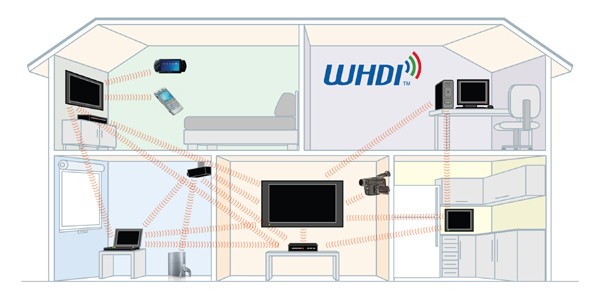
Brite-View BV-2500 Wireless HD Video Transmitter and Receiver Kits
This device has many absolutely accurate clones, here are just a few of them: marmitek GigaVideo800 HDMI , Cablesson Wireless i90 , Gonbes gbs-330
.
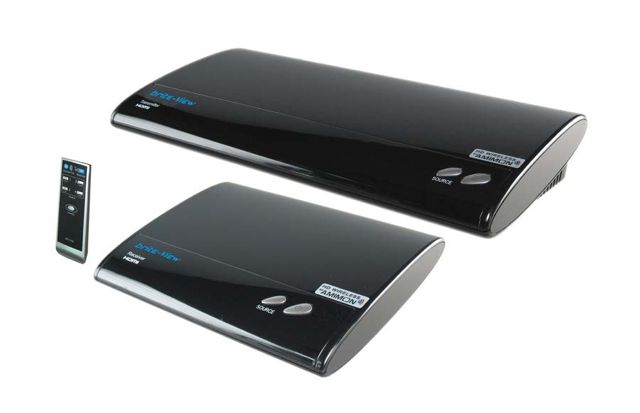
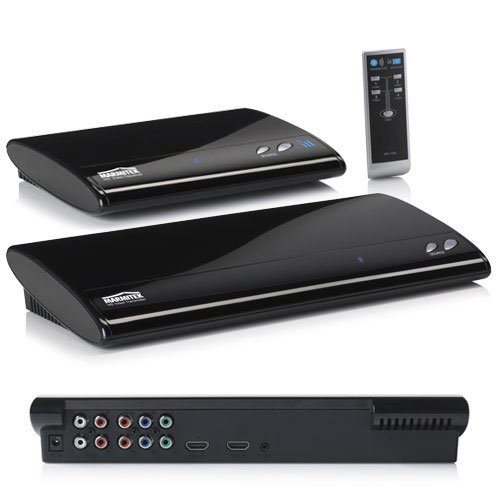
Transmitter:
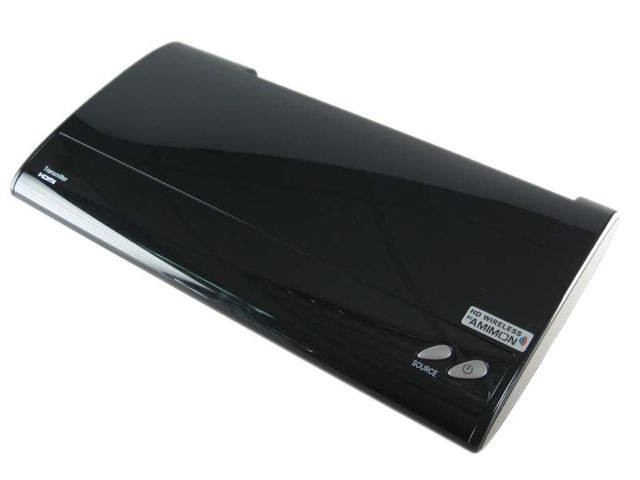

Receiver:

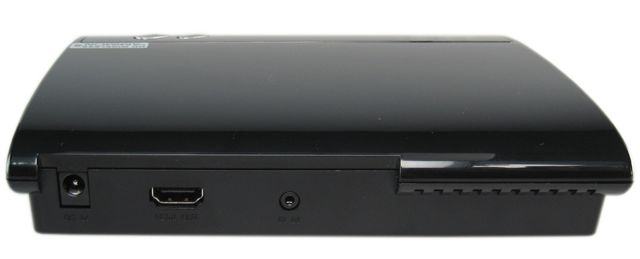
GefenTV Wireless for HDMI
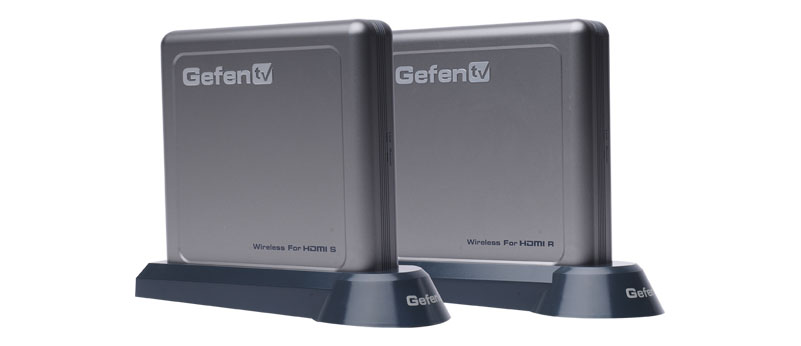
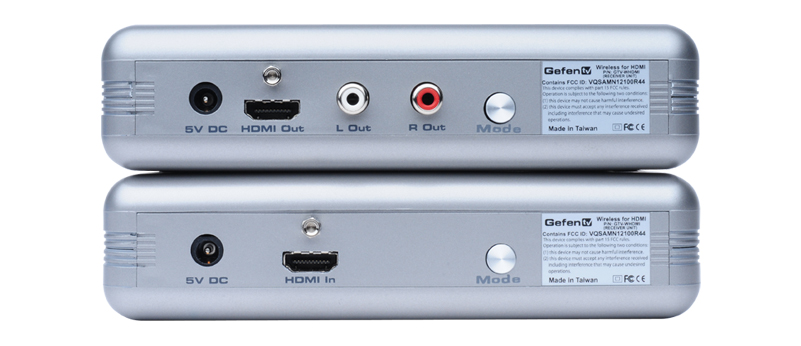
CWHDI-TXRX - Digital HDMI Wireless Sender
Transmitter:


Receiver:


As you have noticed, in almost all units you can connect several sources to the transmitter (for example, a set-top box and a laptop) and quickly switch between them. This is done in order not to poke the wire into another device each time. Simultaneous transmission from two sources (so far) is not possible.
The important point is that when a signal passes through obstacles, a time delay of 10 to 100 milliseconds is possible, depending on the composition and thickness of the obstacles, which, together with the maximum 30 frames per second, makes the solution unsuitable for full-fledged HD interactivity, such as playing consoles in some conditions.
From WHDi, since no feedback is needed to view HD video, the solution would be ideal when transmitting high-quality content through one or more walls / floors / ceilings.
The creators of the standard also promise that in the coming months devices will appear on their new chip , while the transmission delay will decrease several times, as well as the signal compression level, and the frame rate in 1080p video will reach maximum 60fps.
UPD.: It seems that revolvers like ASUS ( seriously? ) Took on the promised news with the transfer of 1080p @ 60 and, presumably, the new WHDi is the basis of HP crafts ( interesting ).
Also, two new items on the new WHDi-chip are presented by the American Brite-View - a compact, USB- powered HDelight transmitter - competing to devices from ASUS and HP, as well as super - powered Air-SyncHD , capable of transmitting high-quality HD-video with the lowest delay transmissions - less than 1 ms .
It should be immediately noted that proprietary technologies are very, very difficult to survive in the market of wireless transmission of video and sound, because they are simply “rolled out” by alliances of major manufacturers that have arisen around the already formed standards. Many of the previously existing, patented developments have already “fallen asleep in the Bose.” However, occasionally there are still quite high-quality solutions for closed technologies, here are the most successful of them:
The characteristics (and, accordingly, the ratings) are very similar to the latest version WHDi:
The device, originally presented by the Korean company Itrio , also produces American IOGEAR and European Eminent .
This furious monster is able to both transmit and receive signals via HDMI, VGA, RCA (audio-video tulips), SCART, component RCA, 3.5mm-jack. At the same time, it is possible to even transmit over a wired LAN, in which case the possible distance between the receiver and transmitter will depend on the capabilities of the network itself.
Itrio (on the left - the receiver, on the right - the transmitter):

IOGear (here tulips instead of SCART, otherwise is identical to Itrio):
behind (on the left - the receiver, on the right - the transmitter):
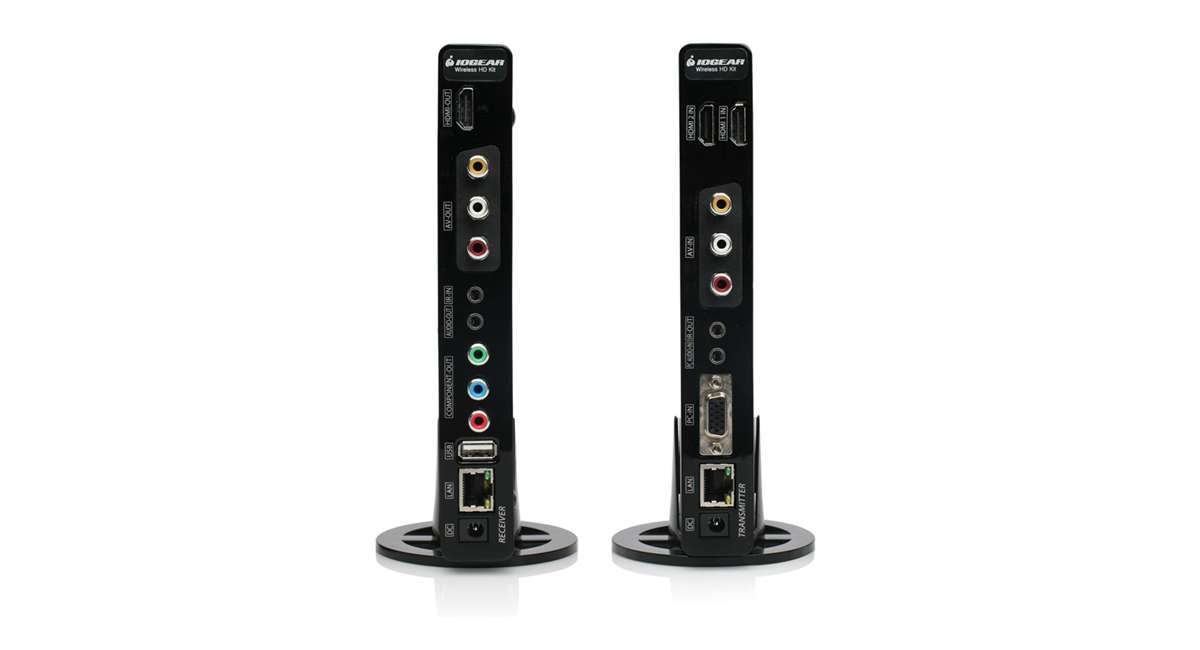
in front:
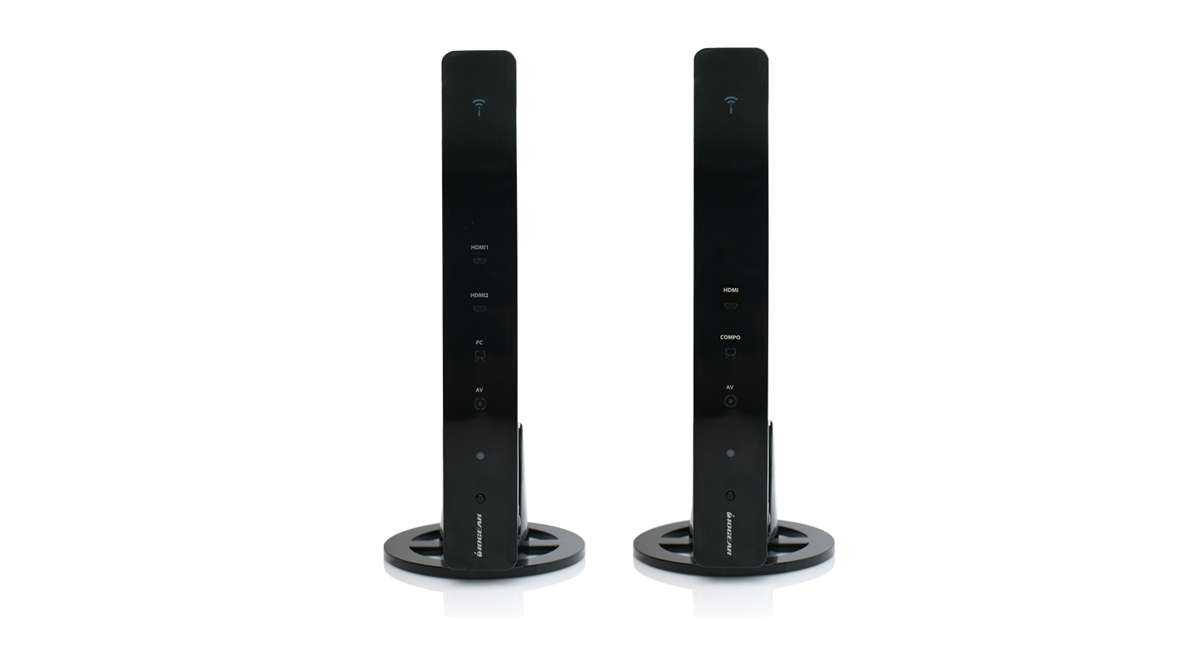
general view and scope of delivery:
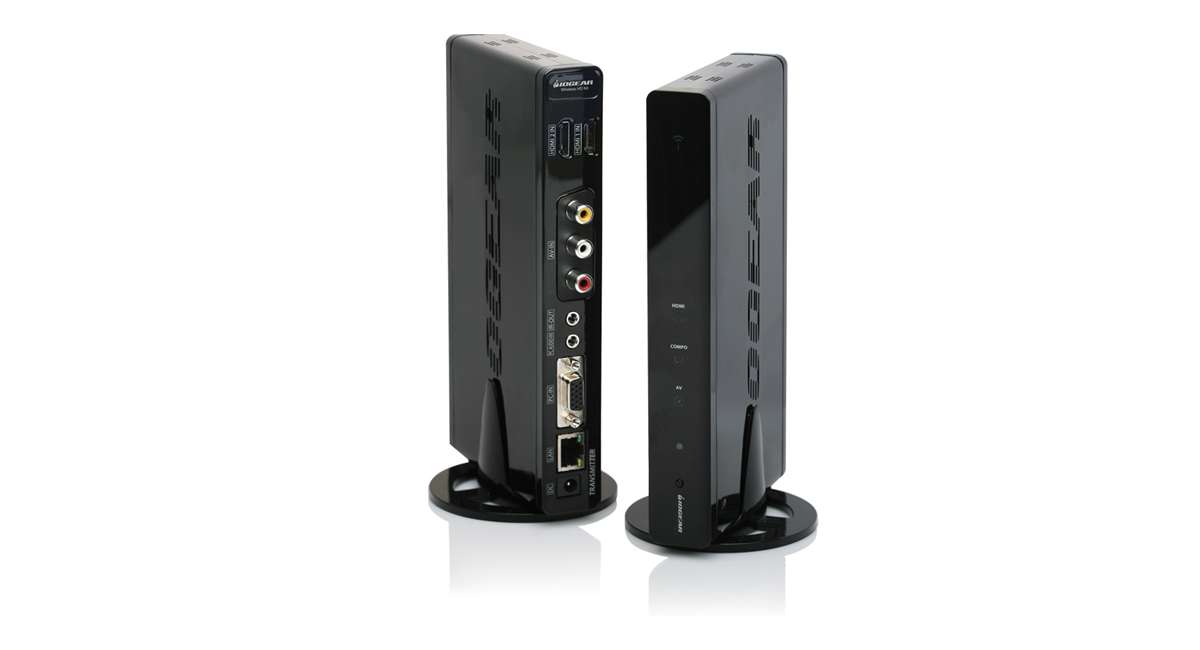
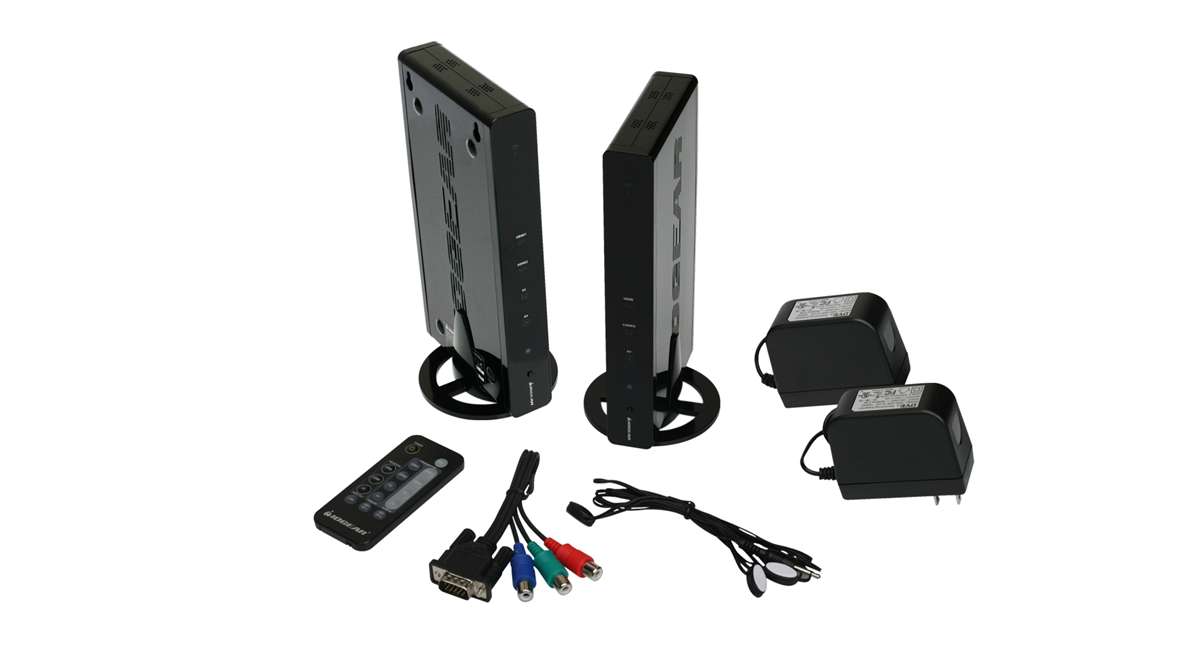
Apart from the others, this powerful device is based on the same Wi-Fi 802.11n, capable of covering a large area with wireless video and sound transmission, with a radius of up to 270 meters , however, which has not yet arrived on the market. The manufacturer’s promise in this direction is very vague: “It will be available, presumably, closer to the New Year.”
Ratings:
kit “receiver-transmitter-remote”:
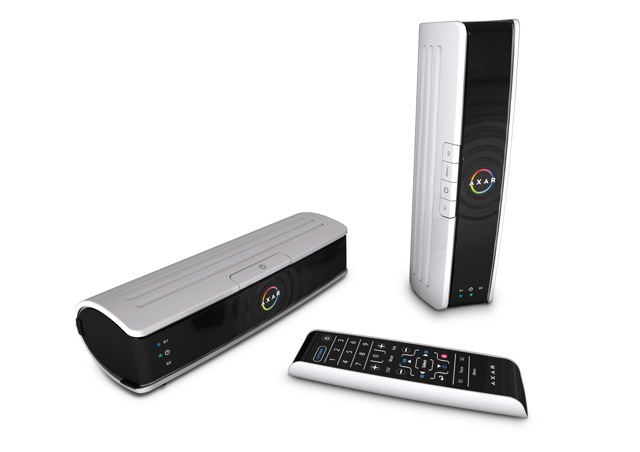
provides a signal to the whole cottage:
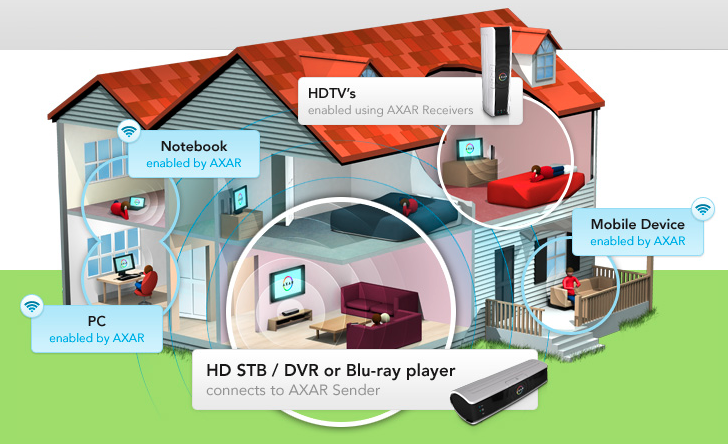
in comparison with the TV:
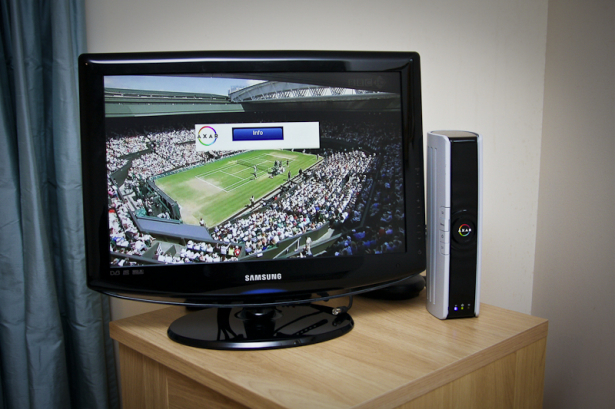
The device has an interesting feature - since the wireless transmission is based on open protocols, it is possible to send video and sound to the receiver, for example, from a VLC player from a computer / laptop via Wi-Fi.
This technology has not withstood the competition from the side of the above comrades. However, one of her offspring still deserves close attention:
Gefen Wireless for HDMI UWB Extender.
This is the only broadband device capable of driving a generally uncompressed video through walls.
Ratings:
transmitter:
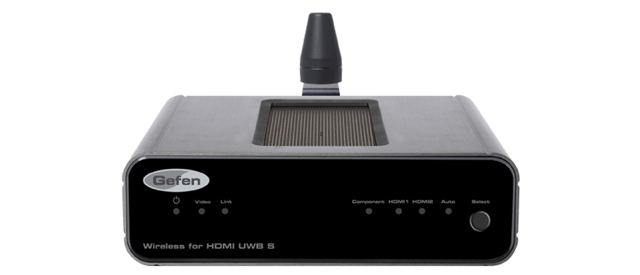

receiver:
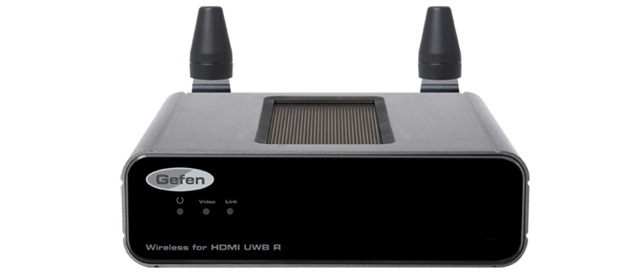

both:
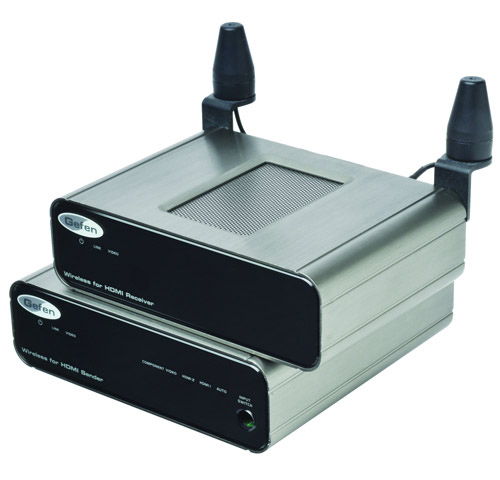
Today, one can judge about the high dynamics of the industry, the mere fact that during the writing of the review (autumn) already four (!!!) extenders / video senders for the HD signal were presented. The author is currently working on finding material for a review of new products.
The greatest progress and speed of development is observed in the WHDi standard (AMIMON), which is already capable of transmitting wireless video and sound of almost the highest quality (1080p @ 60Hz, Dolby 5.1) through walls and other obstacles, and in 2010 they promise 3D support. The price of the decisions based on WHDi is also good.
The remaining solutions are either in the embryonic stage (ProVision AXAR), or have already left the market (TZero). Also, for many, the price has not yet fallen to an acceptable value and, with the highest quality, the transmission distance is small (WirelessHD).
See you at Habré!
UPD .: Going to lunch at Habr, was surprised to find that habraeffect punched DropBox, overflowing images habreffect.ru in the process. I apologize for the inconvenience.
UPD2 .: Pictures reloads on reliable hosting, once again sorry for the inconvenience.
((Caution, Traffic!))
')
The essence of extenders
So, before rushing to study specific pieces of iron, let's first look into the essence of the extenders themselves. The word extender comes from the English verb “extend” - to expand. That is, the devices are designed to expand the transmission of video and sound from one device to another / others, while the receiving and transmitting devices themselves should not “strain” and “notice” any intermediate units. Transmission should be transparent.
Why is it taken exactly HD-video and nothing less? - you ask. The answer is: in fact, through extenders, you can transfer not only HD, but since all the units considered in the article are relevant for today, they are aimed at working with the modern HDMI interface, which combines video and sound, and is oriented mainly to HD quality, we’ll dwell on it. In the end, if you are still interested in transmitting video and sound wirelessly with devices from the “pre-HD-shnoy” era, you can look into the very first article, there are several links. But back to the extenders.
In short, extenders are designed to simply remove the HDMI wire without loss of signal transmission between any devices that can be connected with this wire.
For example, suppose you have a Sony PlayStation 3 or Xbox 360 console , or a laptop with an HDMI / DVI output , from which / from which you want to transmit wireless video and high-quality sound to an HD TV. Then, instead of a long connecting HDMI cable to a set-top box or laptop via HDMI (if in a DVI laptop, via an adapter) you connect the first component of the extender - the transmitter (transmitter) to the TV, also using HDMI, connect the second component of the extender - the signal receiver (reciever ). Wireless communication is established between the transmitter and receiver. It doesn’t matter to you what protocol and its characteristics are used there, you have everything left as it was: HDMI at the input, HDMI at the output. Only between the source and receiver there are no wires. No need to install any drivers or additional software, your devices will still think that they are connected by an HDMI cable.
Again, do not forget that additional energy is required for receiving and transmitting such data volumes, so both the receiver and the transmitter as part of the extender must be plugged into an electrical outlet or, if the extender manufacturer has provided such a possibility, power the transmitter and / or receiver the port .
I repeat that any device with an HDMI output can act as sources in such a scheme: set-top boxes, DVD / Blueray players, media servers (for example, like Bumburum has), video cards and motherboards, as well as nettops with built-in port HDMI, laptops, smartphones and tablets (the same HTC EVO 4G or Dell Streak with the ability to output an HDMI signal).
The receiver, respectively, can be any device that has an HDMI input , of which there is now a great variety: HD-ready and FullHD TVs, monitors, projectors, audio-video capture cards.
At the heart of extenders, even though this is transparent to the user, it is still some kind of standardized, or proprietary, wireless signal transmission technology. The main technologies of this kind were discussed in sufficient detail in the previous article, so we can only group the existing solutions by the technologies used and give them consumer evaluations.
Grades will be awarded in the following categories:
1.Maximum quality of transmitted audio / video
- Video up to 1080i inclusive, and stereo sound or 5.1 - rating 3 .
Thinking a little, I decided not to inflate this, and so already resulting not very small, review, therefore, a detailed description of (irrelevant) devices with only 1080i support will be omitted. I can only say that at different times in this field Sony , Philips , Belkin managed to be noted.
- Video up to 1080p @ 30Hz (30fps, frames / sec.) Inclusive, and sound 5.1 - rating 4 .
- Video up to 1080p @ 60Hz inclusive, sound 7.1 - rating 5 .
2. Maximum transmission distance
- one room (10-20 meters), direct visibility, but possible obstacles (chair, person) - score 3.5 .
- the signal passes through the walls, 30-50 meters - grade 5 .
3. price in Western stores (if you suddenly find devices in the CIS, the pricing formula may not be amenable to even the most inquisitive minds)
- up to $ 300 - rating 5 .
- up to $ 500 - rating 4 .
- over $ 500 - rating 3 .
And we start with ...
Wirelesshd
Since all the pieces of hardware listed below are built on the same SiBEAM chip (more about this in the previous article), they will differ only in brand, price and appearance. So, the general assessment for all for quality and distance:
Quality: rating 5 (Video up to 1080p @ 60Hz, sound 7.1)
Distance: score 3.5 (one room (10-20 meters), direct visibility, but minor obstacles are possible).
Now (hooray!) Glands:
GEFENTV WirelessHD for HDMI




Price: ~ $ 900 - $ 1000, rating 3 .
BEST BUY Rocketfish WirelessHD




Price: ~ $ 600, rating 3+ .
Cables To Go TruLink 1-Port 60GHz WirelessHD Kit





Price ~ $ 410, rating 4 .
As you can see, all devices are quite expensive and are not capable of transmitting a signal through any serious obstacles. However, in return we get the highest (say, even the highest possible) HD video quality 1080 @ 60fps and 7.1 sound without a single delay. As a brief fact about the product, I will say that the boxes use a receiving-transmitting array of as many as 36 antennas, which ensures such high quality.
WHDi
Let me remind the reader that all WHDi devices use the same set of AMIMON chips, and you can refer to the previous article for details on the operation of this technology. Also, the technical details of the standard are described well here . In short: it does not use 36 antennas, but only from 2 to 5, and the signal is encoded (compressed) to fit into a dedicated radio band.
General evaluation of all WHDi devices:
Quality: score 4 (Video up to 1080p @ 30Hz (30fps, fps) inclusive, and 5.1 sound).
Distance: score 5 (the signal passes through the walls, 30-50 meters)

Brite-View BV-2500 Wireless HD Video Transmitter and Receiver Kits
This device has many absolutely accurate clones, here are just a few of them: marmitek GigaVideo800 HDMI , Cablesson Wireless i90 , Gonbes gbs-330
.


Transmitter:


Receiver:


Price: depending on the brand - ~ $ 210 - $ 540, rating 5/3 .
GefenTV Wireless for HDMI


Price: ~ $ 530 - $ 900, rating 3 .
CWHDI-TXRX - Digital HDMI Wireless Sender
Transmitter:


Receiver:


Price: ~ $ 1170, rating 3- .
Summarizing WHDi
As you have noticed, in almost all units you can connect several sources to the transmitter (for example, a set-top box and a laptop) and quickly switch between them. This is done in order not to poke the wire into another device each time. Simultaneous transmission from two sources (so far) is not possible.
The important point is that when a signal passes through obstacles, a time delay of 10 to 100 milliseconds is possible, depending on the composition and thickness of the obstacles, which, together with the maximum 30 frames per second, makes the solution unsuitable for full-fledged HD interactivity, such as playing consoles in some conditions.
From WHDi, since no feedback is needed to view HD video, the solution would be ideal when transmitting high-quality content through one or more walls / floors / ceilings.
The creators of the standard also promise that in the coming months devices will appear on their new chip , while the transmission delay will decrease several times, as well as the signal compression level, and the frame rate in 1080p video will reach maximum 60fps.
UPD.: It seems that revolvers like ASUS ( seriously? ) Took on the promised news with the transfer of 1080p @ 60 and, presumably, the new WHDi is the basis of HP crafts ( interesting ).
Also, two new items on the new WHDi-chip are presented by the American Brite-View - a compact, USB- powered HDelight transmitter - competing to devices from ASUS and HP, as well as super - powered Air-SyncHD , capable of transmitting high-quality HD-video with the lowest delay transmissions - less than 1 ms .
Proprietary (closed, patented technology)
It should be immediately noted that proprietary technologies are very, very difficult to survive in the market of wireless transmission of video and sound, because they are simply “rolled out” by alliances of major manufacturers that have arisen around the already formed standards. Many of the previously existing, patented developments have already “fallen asleep in the Bose.” However, occasionally there are still quite high-quality solutions for closed technologies, here are the most successful of them:
Based on Wi-Fi 802.11n 5Ghz
The characteristics (and, accordingly, the ratings) are very similar to the latest version WHDi:
Quality: a rating of 4.5 (Video up to 1080p @ 60Hz (60fps, fps) inclusive, and 5.1 sound).
Distance: score 5 (signal passes through walls, 30 meters).
Price: ~ 330 $ -1000 $, estimate 4/3 .
The device, originally presented by the Korean company Itrio , also produces American IOGEAR and European Eminent .
This furious monster is able to both transmit and receive signals via HDMI, VGA, RCA (audio-video tulips), SCART, component RCA, 3.5mm-jack. At the same time, it is possible to even transmit over a wired LAN, in which case the possible distance between the receiver and transmitter will depend on the capabilities of the network itself.
Itrio (on the left - the receiver, on the right - the transmitter):

IOGear (here tulips instead of SCART, otherwise is identical to Itrio):
behind (on the left - the receiver, on the right - the transmitter):

in front:

general view and scope of delivery:


Provision AXAR1500
Apart from the others, this powerful device is based on the same Wi-Fi 802.11n, capable of covering a large area with wireless video and sound transmission, with a radius of up to 270 meters , however, which has not yet arrived on the market. The manufacturer’s promise in this direction is very vague: “It will be available, presumably, closer to the New Year.”
Ratings:
Quality: If you believe the promises of the manufacturer - a rating of 5 (HD-video and sound of the highest quality and without delay).
Distance: again, according to the manufacturer, a score of 5 ++ (the signal passes through the walls, the covering radius is the maximum of all known - 270 meters, a normal-sized cottage with delivery to all rooms can provide a signal).
kit “receiver-transmitter-remote”:

provides a signal to the whole cottage:

in comparison with the TV:

Price: unknown, but judging by the quality and size, the most likely estimate will be 2 .
The device has an interesting feature - since the wireless transmission is based on open protocols, it is possible to send video and sound to the receiver, for example, from a VLC player from a computer / laptop via Wi-Fi.
Ultra Wideband TZero Technology
This technology has not withstood the competition from the side of the above comrades. However, one of her offspring still deserves close attention:
Gefen Wireless for HDMI UWB Extender.
This is the only broadband device capable of driving a generally uncompressed video through walls.
Ratings:
Quality: score 4 (Video up to 1080p @ 30Hz (30fps, fps) inclusive, and 5.1 sound).
Distance: score 4 (transmission up to 10 meters through capital obstacles).
Price: ~ $ 1000, rating 3 .
transmitter:

receiver:

both:

Summing up
Today, one can judge about the high dynamics of the industry, the mere fact that during the writing of the review (autumn) already four (!!!) extenders / video senders for the HD signal were presented. The author is currently working on finding material for a review of new products.
The greatest progress and speed of development is observed in the WHDi standard (AMIMON), which is already capable of transmitting wireless video and sound of almost the highest quality (1080p @ 60Hz, Dolby 5.1) through walls and other obstacles, and in 2010 they promise 3D support. The price of the decisions based on WHDi is also good.
The remaining solutions are either in the embryonic stage (ProVision AXAR), or have already left the market (TZero). Also, for many, the price has not yet fallen to an acceptable value and, with the highest quality, the transmission distance is small (WirelessHD).
See you at Habré!
UPD .: Going to lunch at Habr, was surprised to find that habraeffect punched DropBox, overflowing images habreffect.ru in the process. I apologize for the inconvenience.
UPD2 .: Pictures reloads on reliable hosting, once again sorry for the inconvenience.
Source: https://habr.com/ru/post/105614/
All Articles